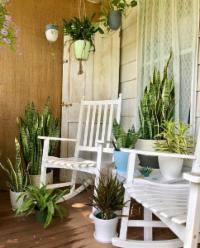
The Houseplants that Came in From the Cold
Nancy DuBruleShare
The Plants That Came in from the Cold: Bringing Your Houseplants Back Inside

Now that the weather is cooling down, it’s time to think about bringing in your tender houseplants and herbs for the winter. The first mild frosts along the shoreline usually occur during the week of the full moon in early October. When you hear that the temperature is going to drop to the low thirties, plants can be easily protected by draping them with sheets or newspaper held on with clothespins. Once the threat of hard killing frost arrives (usually at the end of October) your plants should be in the house. Once inside, there are some important steps that you should take to insure their health and vigor...

First, be aware that when you "summer" your plants outdoors, you are exposing them to potential insect problems. They may look lush and healthy when first brought in, but it is very likely that hidden in their leaves are the egg cases of whiteflies or spider mites. I make it a practice to take preventative measures before a problem arises. Put your plants in the shower and wash them off well. Or, hose them off (top and bottom of the leaves) before bringing them in. Then, inspect carefully. Remove any brown, yellow, or diseased looking foliage. If you suspect insects, you should isolate your plants for a while. I use my back garage. It has a south facing window and even though it is not heated, it stays frost free while I work on the plants. If your plants do have insects, is a good standard practice to spray your plants before they come indoors. We use natural sprays such as Neem, Spinosad, or insecticidal soap. These are effective, yet safe for the environment. The general rule is to spray them three times in a two week period to be sure you control insects and eggs. Or, as an alternative, you can mix up a mild solution of dishwashing soap and water and give your plants a bath. You can't be too careful at this point! It is a lot easier to do this work outside on your deck on a beautiful fall day than in your living room in the dead of winter. An ounce of prevention is worth a pound of cure! Always inspect your plants at least once a week to look for insects and treat them immediately.

The other important job when you are bringing in your plants is to cut them back. I bring in tropical plants such as my hibiscus collection, my night scented jessamine (Cestrum nocturnum), and my collection of begonias. I also bring in a lot of succulents including Christmas and Thanksgiving cactus. Many people bring in geraniums from the garden. When you dig anything up to pot up and bring in, you inevitably dig up some of their roots. Balance this with a top pruning. This will create a bushier plant. Don't worry if you cut off a few flowers or buds. It will be worth it in the long run to have compact, full flowering plants in late winter when you need them the most. The same is true of tender perennial herbs. Rosemary, scented geraniums, and lemon verbena are not hardy in Connecticut. When you bring it in, give them a good haircut (and dry or cook with the clippings). Because the light levels are getting progressively lower at this time of year, cutting plants back helps them adjust to the change. If you notice a white powdery dust on your rosemary plants indoors, you probably have powdery mildew. Mix up one tablespoon of baking soda in one gallon of water and mist on the plants once a week. This takes care of the problem in a safe manner and doesn't change the flavor of the rosemary.
I do not recommend trying to bring in annuals such as basil or impatiens. Although they may live for a month or two indoors, they will decline in vigor because their natural life cycle is to die in the fall. Instead, take fresh cuttings of your impatiens and root them in water or perlite. Once rooted, plant them in potting soil and keep them in a bright, morning sun window. Pinch them at first to encourage bushiness. They will reward you with wonderful color all winter long. Consider sowing the seeds of annual herbs such as basil for a fresh winter crop. Grow culinary herbs on a sunny windowsill. Keep them well watered, especially in the dead of winter when the heat is on, drying out your indoor plants very quickly.

It is important to realize that it is a big adjustment for plants to come in from the outdoors. Try to get them in to the hot, dry air of your house gradually. Many people first put their plants on an unheated sun porch for a week or so to help them to acclimate.
Mist your plants with water often. An easier alternative is to place them on humidity trays: use large saucers that are 4-6” wider in diameter than the pots your plants are growing in. Add pebbles and then add water. Keep the water below the top of the stones as you never want your plants to sit in water. This is an easy way to increase the humidity on a constant basis. You will be surprised how quickly the water evaporates! This is good for your plants and for you!
Indoor plants are one of the joys of the cooler months. If you take a few simple precautions now, you will be rewarded with healthy, healthy houseplants all winter long.
